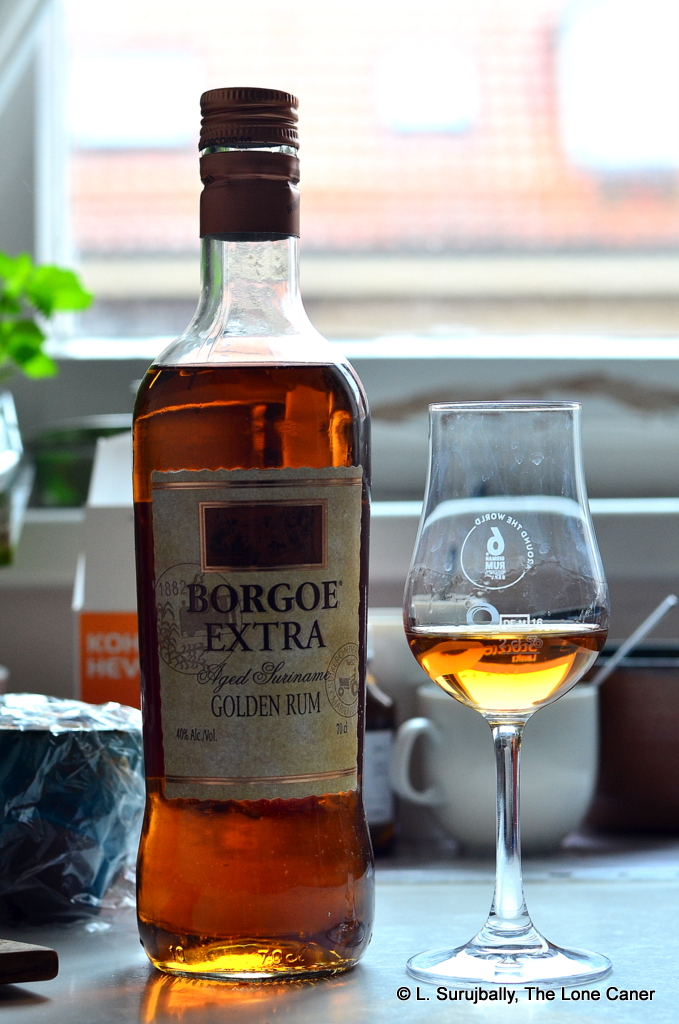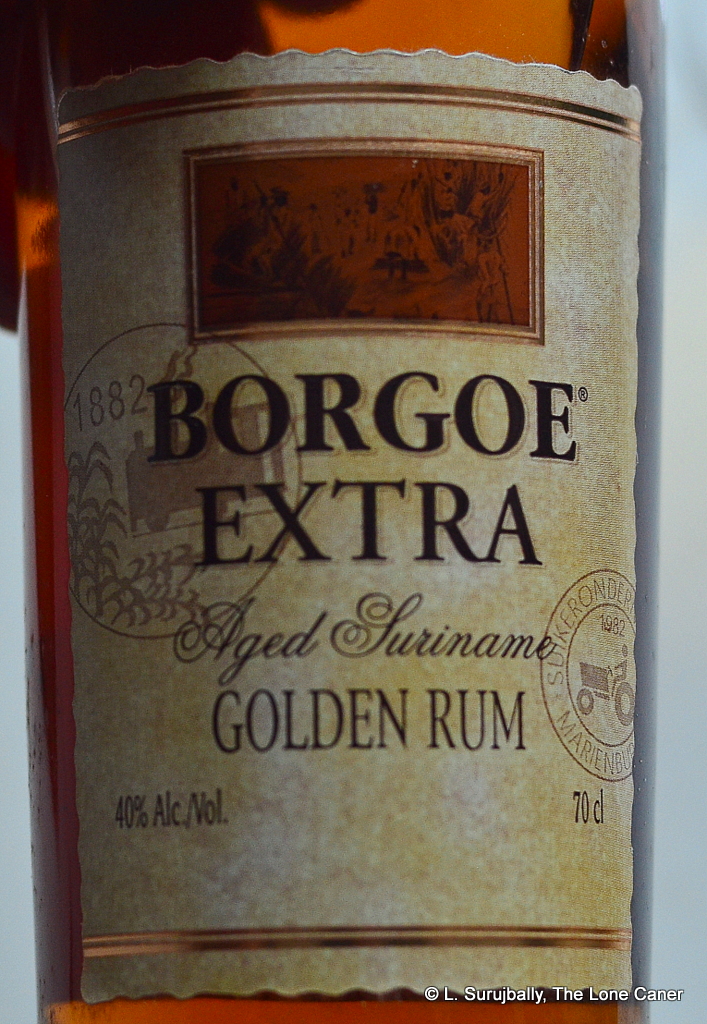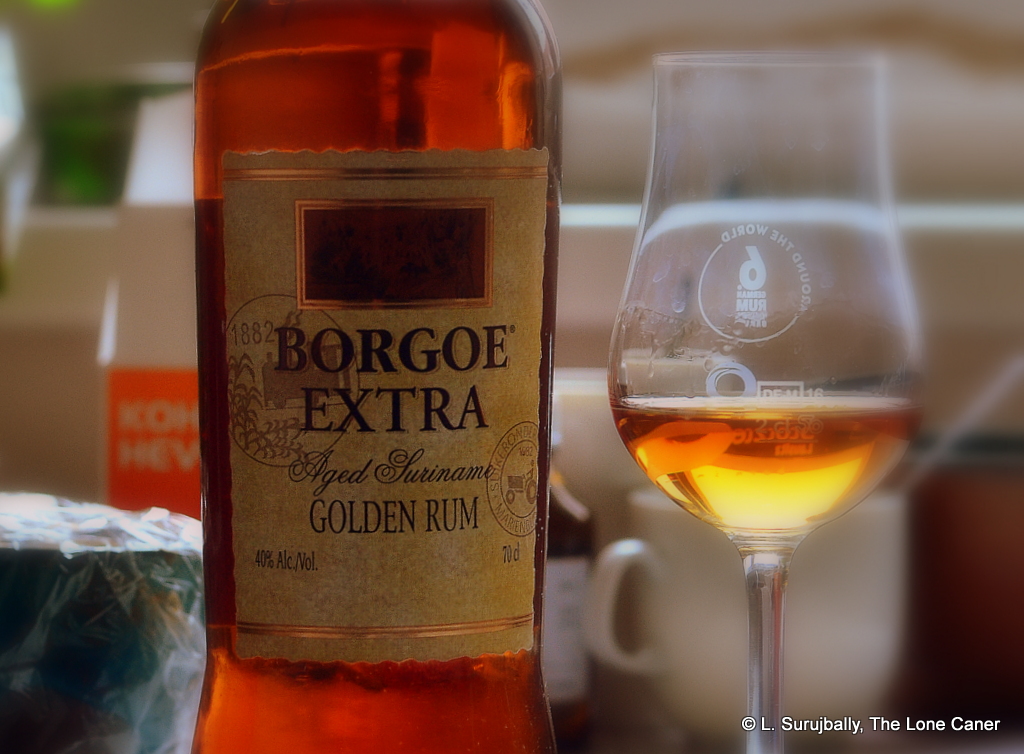#368
There is no shortage of agricoles, independent bottlers and flavour-of-the-month rums in my notebooks — but in late 2016, and again in early 2017, I tried the Borgoe line from Suriname – all 40% rums – back to front, front to back and side by side, twice, and it’s time to see what they’re all about. After all, we all know of the big guns in the rum world but the lesser-known operators deserve their moment in the sun as well.
So let’s start at the bottom and work our way up to the top, young to old, beginning with the Borgoe Extra, an “Aged Golden rum”: this is the light, low-end mainstay of the brand’s offerings, the way the V/X is for Appleton, or various 3-year olds or “gold rums” are for other makers. It’s a successor to the Borgoe ’82 rum first introduced in 1982, and I believe it to be around three years old (other products are the 5, 8 and 15 year old rums), a blend aged in American oak barrels and issued at the usual 40% after being filtered twice.
 Smelling it revealed no real markers of distinction such as would make one wonder into what magical terroire of the mind one had just stumbled all unaware. It was redolent of fleshy fruits, some cherries, caramel and some nougat, nothing terribly complex or ambitious. After resting for some time and coming back to it I could detect orange peel, a flash of something sharp and bitter, cinnamon and some herbs, so pretty standard, all in all.
Smelling it revealed no real markers of distinction such as would make one wonder into what magical terroire of the mind one had just stumbled all unaware. It was redolent of fleshy fruits, some cherries, caramel and some nougat, nothing terribly complex or ambitious. After resting for some time and coming back to it I could detect orange peel, a flash of something sharp and bitter, cinnamon and some herbs, so pretty standard, all in all.
I liked the palate more than the nose (usually the opposite is the case with really young rums, at least for me). It presented as somewhat sharp; then came a swift procession of salty caramel, more nougat, white toblerone, and nuts. An amalgam of a few fruits, — peaches, unripe green apples and ginip, all muddled together — plus the slight citric sting of orange peel again There were faint notes of olives and brine (very faint) and oaken tannins and the bitterness of raw wood chips still bleeding sap, and the whole thing, while quite light, was thin and sharp too, with a short, spicy and rather unremarkable finish mostly providing a closing sense of caramel, apples and sugar water.
Overall, rather uncomplex and unexciting: there was something going on here, just not too much of it (certainly not enough) and it’s insufficient to get excited about at this stage. A word should be spared for the notation that it is not really sweet and quite thin (“scrawny” was the word I scribbled down), which leads me to surmise that dosing is not part of the assembly.
Thinking further through the tasting experience, I believe that thinness aside, what it really lacks is distinctiveness (and, perhaps, punch). The filtration is part of the problem, as is the anemic 40%, and also the column still makeup of the blend leans heavily towards a lighter, more Spanish style. It could just as easily be any young rum from the Dominican Republic, Panama or Belize, and I think the company is much like Banks DIH in that it sticks to the low-strength blends without doing enough to create a particular and clearly Surinamese profile which could potentially showcase the land of origin. It therefore cannot and should not be used on its own; and given its generic nature, I’m not sure whether there’s any particular cocktail that would be made with it to demonstrate and capitalize such attributes it does possess.
 I mean, when you taste a Jamaican, a Guyanese rum from DDL, a St. Lucian or a Bajan Foursquare, you can, with a little experience, use them as markers for the entire country. That’s one reason why they’re so popular – it’s their unique and country-specific profile that makes people go after them and actively source really old expressions. I think SAB might be sitting on some untapped potential just on the strength of this little rumlet — if they were to go with local cane, utilize that pot still more often, and produce some limited editions of greater power. But perhaps we have to go up the ladder to see what the brand has on offer, and if that half-sensed potential I mention can be seen in older variations…or not.
I mean, when you taste a Jamaican, a Guyanese rum from DDL, a St. Lucian or a Bajan Foursquare, you can, with a little experience, use them as markers for the entire country. That’s one reason why they’re so popular – it’s their unique and country-specific profile that makes people go after them and actively source really old expressions. I think SAB might be sitting on some untapped potential just on the strength of this little rumlet — if they were to go with local cane, utilize that pot still more often, and produce some limited editions of greater power. But perhaps we have to go up the ladder to see what the brand has on offer, and if that half-sensed potential I mention can be seen in older variations…or not.
(77/100)
Other Notes
- Rather than go into a long history of the company, I’ll direct you to the Marienburg 90% review with its thumbnail recap for those who are interested.
- The production process is based on molasses sourced from Angostura in Trinidad and not from Guyana right next door, surprisingly enough, and after fermentation, the wash is passed through a columnar still, the resultant being used to make the rums which are aged in American oak barrels. The website of the company notes that a second still is used to make high ABV neutral spirits for the pharmaceutical industry, and they have a third copper still (they call it a “hand still”) for heavier rums – I am assuming this is the pot still some have mentioned to me, though exactly which rums this makes is still unclear at this time. Since the entire line of Borgoe aged rums is blended, no doubt some portion of the pot still finds its way into the various expressions, much in the same way DDL does it with their various stills and the standard El Dorado line.

Small typo in last part: SAG should be SAB.
Fixed, thanks